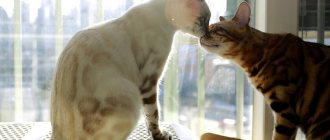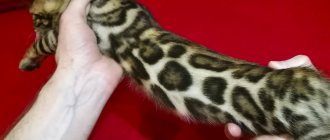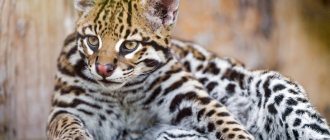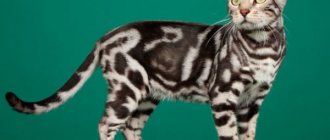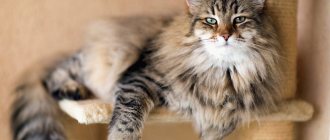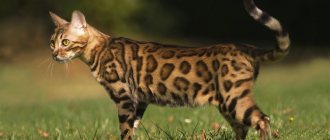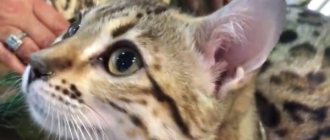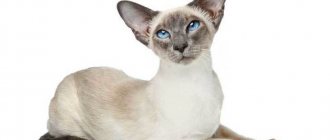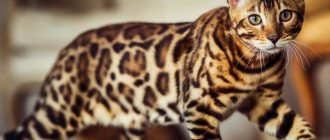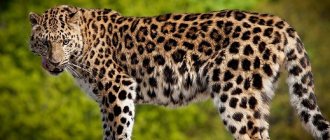General description and area
Neofelis nebulosa is a medium-sized mammal that is the smallest of the big cats.
Sometimes the animal is called a spotted leopard, but from a scientific point of view this is incorrect.
The animal belongs to the genus of Clouded leopards, its second representative (of the genus) Neofelis diardi is the Bornean or Kalimantan Clouded Leopard.
The Latin name "Neofelis" consists of two words and translates as "new cat".
Previously, scientists classified this predator as belonging to the subfamily Felinae. Several anatomical, morphological and behavioral signs indicate that this is essentially incorrect. Neofelis nebulosa is classified as belonging to the class of big cats, but is clearly an intermediate link between two subfamilies existing in the cat family.
The skull and dental structure of Neofelis nebulosa are similar to those of big cats. At the same time, he cannot roar as loudly as lions or tigers, since the hyoid plate is partially petrified and does not vibrate strongly enough. Therefore, the animal, like all small cats, can purr like a domestic pet and softly roar like large wild animals.
The characteristic features of the Clouded Leopard include:
- A powerful and compact muscular body, the length of which is from 65 to 110 cm, and the maximum height is 57. In fact, the wild animal does not exceed the size of an average lynx.
- Low body weight. The weight of males is 14-25 kg, females 10-17.
- The paws are not too long, strong, widening towards the feet. Like all members of the cat family, the Clouded Leopard has five toes on its front legs and four on its hind legs. The claws are completely retracted into the soft pads.
- The head is of medium size, quite strongly extended forward and differs in shape from all other modern wild cats, which indicates the antiquity of the genus. This structure of the skull is due to “saber teeth”; the animal’s fangs are from 3.5 to 5 cm, they are too large for a small animal.
- Due to its large jaw, the Clouded Leopard is able to open its mouth very wide. Moreover, the angle between the upper and lower parts is almost 90 degrees; in most other wild cats it does not exceed 65.
- The face has a characteristic cat “mask” consisting of black lines and markings.
- The eyes are large, medium set, round with a slit-like pupil. They can be green, yellow or golden emerald.
- The ears are high set, but slightly tilted to the sides. They are small in size and rounded at the tips.
- The nose is large with a pink or brick protruding nose.
- Short, close-fitting coat of unusual spotted color. It resembles the colors of marble cats. The main background is yellowish-golden, the spots are large, irregularly shaped, black. On the ridge and chest they are more elongated and dark brown.
- The tail is long and heavy, up to 95 cm. Decorated with torn charcoal rings.
This predator lives in some countries of Southeast Asia. Previously, it was found everywhere in this region, but today colonies in Assam, Sumatra, Taiwan, and Java have completely died out.
Nowadays, small populations of Clouded Leopards can be found only in the territories from the southern regions of the Chinese provinces to Melaka, as well as from the eastern border of the Himalayan Mountains to Vietnam. Predators inhabit the foothills of the Himalayas, Nepal, India, Myanmar, Bhutan, Thailand, Malaysia, Indochina, China in the southern floodplain forests near the Yangtze River.
Small populations have been found in the jungles of Bangladesh. In Indian territories they live in West Bengal, Sikkim, Manipur, Tripuri and some other provinces.
For a long time, clouded leopards could not be discovered again in Nepal and were considered extinct, but at the end of the last century, two mature pairs were found in the area of Chitwan National Park.
Most likely, there is a gradual movement of populations into western Asian regions, that is, the clouded leopard is quite capable of breeding and existing in degraded forests.
The main habitat of the predator is tropical and subtropical jungles. These can be evergreen dense forests, mangroves, savannah, even high-mountain plateaus overgrown with trees, located at an altitude of up to 2.5 thousand meters above sea level.
Most clouded leopards are found in Borneo, since tigers and leopards, which in the wild are the sworn enemies of the average cat, do not live there.
Savannah
The largest cat that looks like a leopard is the Savannah. This hybrid has the greatest resemblance to a wild animal. This is a unique and very expensive animal, the cost of an individual is from $4,000.
The breed appeared from crossing a wild serval and an ordinary domestic one; it has a large appearance with long legs, a neck, and huge ears. The official registration of the breed with all its standards in the international cat association occurred in 2011.
The signs observed in habits are as follows.
- Significantly larger than regular cats, Savannah cats are very playful and intelligent.
- They are easy to train, enjoy walking outside on a leash, do not like the cold, but are willing to swim.
- They are easily toilet trained and do not require a strict diet or special care.
- They show affection to their owners and are friends with children and other pets.
Although this is a young breed, not yet fully housetrained. The cat's habits are such that no sudden movements should be made near it, as it will immediately attack an object. In this case, no aggressive anger is observed, only a manifestation of a reflex.
Classification of clouded leopard subspecies
Scientists currently distinguish three subspecies of the clouded leopard, living in different territorial zones:
- Neofelis nebulosa nebulosa - its natural habitat is Indochina and China.
- Neofelis nebulosa macrosceloides inhabits the territory of Myanmar and Nepal.
- Neofelis nebulosa brachyura – Taiwan Clouded Leopard. From the point of view of scientists, this is a completely extinct species.
The Bornean Clouded Leopard was previously also considered a subspecies of Neofelis nebulosa, but in 2006, scientists conducted genetic studies that made it possible to establish that this predator was formed from a mainland ancestor 1.4-2.9 million years ago and is an independent species of Neofelis diardi.
Taiwan Clouded Leopards
Neofelis nebulosa brachyura was endemic to Taiwan. For a long time, no traces of a single predator could be seen on the island, so scientists came to the conclusion that this population has died out completely.
In their morphology and behavioral characteristics, these predators were similar to the animals inhabiting mainland China. Taiwanese Clouded Leopards barely reached a mass of 17-18 kg and their difference from all other subspecies was their significantly shorter tail, no less than one and a half times.
The last representative of this subspecies was seen by people in 1983. Most likely, due to the active deforestation of tropical forests on the island, the animals rose to the foothills and were exterminated by poachers.
At the beginning of this century, several attempts were made to find predators in the mountains; about two thousand video cameras with infrared imaging were installed there.
Scientists led by zoologist Chang Po-Jen hoped that several individuals of the Taiwan Clouded Leopard were still preserved high in the mountains and continued their research. In 2021, the first report finally appeared that several animals were caught on CCTV cameras.
This animal has always been an important figure in the culture of the island. Thus, clothes for religious cults were made from the bright skins of predators. The brave hunter who caught it was considered a hero.
Many tribes, such as the Rukhai, have always prohibited hunting the Clouded Leopard. According to their legends, the spirit of a predator is a guide for the souls of the dead to the underworld. According to beliefs, killing an animal leads to grave misfortunes for the entire tribe.
We can only hope that the Taiwanese Clouded Leopard actually survives in the mountains, and that people will be able to preserve and increase this rare population in the future.
Arabian Mau
It also has spots, and the coat itself has no undercoat. Color ranges from white with black spots to black without spots. The main color of the breed is brown or gray with patterns.
This cat cannot claim the title and is only temporarily recognized, but in 2008 it was standardized. For the Middle East, this animal is native. Characteristics: Large size, muscular, high legs, tapered tail. The paws are rounded, and large ears are located above the head. Males are larger than females, weighing up to 8 kg.
The Arabian Mau has oval eyes that match the color of its coat. Friendly character: accompanies owners, plays with children. Care - weekly brushing, ear cleaning, walks.
The breed standards are as follows:
- A muscular body with long legs cannot be called very slender.
- The coat is adjacent to the body, hard, and in adult specimens silkiness is excluded.
- The coloring is very diverse: black spots on a white background and white on black, tabby (pattern on the body), gray and brown tones.
Features of behavior
Clouded leopards differ from other small and big cats in their behavioral habits.
Due to the not too long, but powerful paws of the animal, the center of gravity is low, so it is stable among tree branches. The powerful wide tail in this case is an additional balancing act.
By observing individuals living in the zoo, scientists made sure that the clouded leopard is able to calmly move along horizontal branches of different height levels and can even hang upside down. At the same time, it holds itself only with its hind legs.
This is exactly the technique that a predator uses when hunting for birds and monkeys located on the branches below it. Although it is more of a nocturnal predator, it does not refuse daytime hunting. The animal is capable of catching prey on the surface of the ground, but more often it jumps on deer and goats from the lower branches of nearby trees.
In those areas that are located close to human habitations, the predator is more cautious and prefers to hunt only at night. Due to the binocular special structure of the eyes, clouded leopards at this time of day see seven times better than humans.
The animal is a good swimmer and can cross large expanses of water, occasionally going out onto land for a short rest. At the same time, he does not refuse to hunt fish and reptiles.
Due to the huge “saber-toothed” fangs, the Clouded Leopard can easily hold caught prey on a tree branch, and this is much more difficult than catching it on the ground.
Killing a victim with one bite is the signature trick of the Clouded Leopard. There is a large gap between the long canines and premolars, which also contributes to the depth of tooth penetration.
This is a solitary predator, marking and actively protecting its territory from strangers. It is difficult to see it; more often the animal hides in dense thickets. Of all the wild cats, he is the best at climbing trees.
When observing the hunting of these wild cats, scientists found that most of their victims die in the trees; they hunt less on the ground.
The animal also likes to move on the ground, bypassing its hunting grounds. At the same time, he climbs onto tree branches only for a short rest.
Clouded leopards make a variety of sounds when communicating with their relatives - meow, hiss, growl, snort, moan. The snorting of two males when they meet is a sign of a friendly disposition.
Bengal cat personality
The combination of the temperament of a wild animal and an affectionate domestic animal is a key feature of the Bengal cat. She has a well-developed hunter's instinct. At any age, your pet will play with balls and chase toys.
Animals are adapted to life in a pack. When raising a kitten, you need to devote enough time to it and accustom it to handling so that it does not shy away from people. Contrary to popular belief, the Bengal cat is not known for its aggressive behavior. Rather, on the contrary: these animals love children and easily get along with other pets.
Problems can only arise with rodents and birds, since the Bengal perceives them as prey. If there is constant communication with the owner, the cat will become his faithful and affectionate friend.
Cats of this breed do not tolerate separation from their owner well; they may become sad and refuse to eat. Therefore, if necessary, it is better to leave the animal with familiar people.
Many Bengals love to swim. A Bengal cat can use any container with water of sufficient volume to splash around.
The animal is easy to train and quickly masters a set of basic commands. These cats are very smart and can walk with their owner on a leash.
Diet of the Clouded Leopard
Since this animal spends most of its time in tropical forests, very little is known about it, including its feeding habits.
Scientists suggest that the diet of this predator is based on small representatives of wild fauna; in particular, the predator eats:
- pheasants;
- monkeys;
- antelope;
- deer;
- wild goats;
- wild pigs;
- rodents and squirrels;
- reptiles;
- young artiodactyls;
- porcupines.
Of the monkeys, the beast most likely attacks palm civets and macaques, which also live in trees.
Despite its small size, the Clouded Leopard is capable of knocking down a young buffalo. In this he is helped by powerful, saber-like fangs and strong paws with sharp claws. Due to its teeth, the animal can take the life of its prey with one precise bite.
The hunting grounds of one mature individual are large - up to 45 square meters. km. In a day, the predator can cover up to two kilometers of the jungle in search of prey.
Habitats
The most densely populated areas where leopards live are forests and savannas. However, they give their choice to the trees.
Note!
Car hammock for dogs. What it is?- Removal and cremation of animals
Cynologists - who are they?
Birth of kittens and lifespan
The difficulties of breeding clouded leopards in captivity are associated with the peculiarity of these animals.
Most of the time they lead an exclusively solitary lifestyle. A pair is formed only during the mating season.
After mating, males become aggressive; if the female remains nearby, she most often dies, in almost 70-80% of cases.
Very little is known about the reproduction of clouded leopards in natural habitats due to the secrecy and caution of the animal.
Presumably, the period of courtship, rutting and birth of babies occurs in March-August. The animals mate almost constantly for several days, then the female leaves the male forever. All worries about the offspring fall only on her shoulders.
The gestation period for animals is quite long and corresponds to large cats - 83-98 days.
The female most likely chooses a large hollow as a den. There are from one to six kittens in a litter, but more often there are two or three.
A Clouded Leopard kitten is born weighing about 150-300 grams, blind and completely helpless. It is covered with grayish fur, the spots are practically invisible.
Already at 10-12 days, the babies open their eyes, by one and a half months they actively begin to eat meat, and by six months they acquire the color of an adult.
The mother suckles for up to 5-6 months, and before the end of the first year of life they become completely independent, but sexual maturity occurs only at two years.
Animals live in captivity for 15-20 years, in the natural environment less - 10-12.
Kanaani
The Kanaani cat (or Canaani) is a new breed bred by an Israeli resident D. Pollacek, registered in 2000. Several breeds were crossed: Bengal, Libyan steppe, Abyssinian, common domestic and others.
The mixture of Libyan and homemade turned out to be the most successful. The animal has an independent character, distinguished by its love of walks and freedom. But the cat also adapted well to the new environment, was unpretentious in care and undemanding in nutrition. Balanced habits and love for affection do not exclude the fact that she definitely needs a leash on the street, otherwise she will run away.
The Kanaani is a breed with a short, coarse coat that ranges in color from light yellow to brown with contrasting spots. At medium size, large specimens are found.
They are strong, have well-developed muscles, high legs, on which they run quickly. It is necessary to add almond-shaped eyes and tufts on the ears of some individuals. Health is good, you just need to find a common language with your pet in order to live in harmony with it.
Mr. Cat talks: the life of clouded leopards in captivity
Clouded leopards are now found in many large zoos around the world. Here they are trying to create conditions that are completely close to their natural habitat, providing them with a nutritious diet and quality care.
Despite this, animals have a very difficult time breeding in captivity. The appearance of the offspring of Clouded Leopards in any zoo is a real event.
To overcome the aggression of males after copulation, it is now practiced to keep males and females together. In addition, scientists hope that in the future it will be possible to produce cubs through artificial insemination and embryo transfers.
These animals should absolutely not be kept at home. The animal requires a very large enclosure that provides activity, tall trees, a pond, and thickets of grass.
Nevertheless, there are specialized nurseries for these animals. The cost of a kitten there starts from 25 thousand dollars.
In captivity, predators eat fresh meat, bones, fish, and are also given vitamin and mineral complexes. They take excellent care of the health of beautiful pets - timely deworming, treatment for external parasites, and vaccination.
Zoo visitors have often been able to observe how, in hot weather, marbled predators feast on a kind of fruit ice cream made from large pieces of frozen papaya.
Pet care
Caring for an Ocicat is not particularly difficult. The animal, like all felines, is very clean. It is enough to comb dead hairs from the fur coat with a soft brush once a week.
- It is recommended to bathe no more than once every six months. It is better to accustom a handsome spotted cat to water procedures from childhood, then there will be no special problems in adulthood.
- In addition to caring for the fur coat, regular cleaning of the ears, eyes, and teeth is necessary. For claws, purchase a scratching post.
- The Ocicat's diet must be correct. It is unacceptable to feed your pet low-quality food. If you decide to give priority to a natural menu, exclude fatty meat and dairy products from it. Advice from an experienced veterinarian will not hurt when compiling it.
Interesting facts about the Clouded Leopard
From ancient times to the present day, the most important enemy of these beautiful wild cats has been humans. Due to the uncontrolled destruction of these animals by humans, they are now on the verge of extinction.
The clouded leopard is listed in the International Red Book as an endangered species and is protected by the states of many countries. No more than ten thousand individuals of these unique animals now live on the planet.
For many centuries, expensive fur coats were made from the beautiful skins of the Clouded Leopard, and the skeleton, teeth, and entrails were used to make potions in oriental medicine.
Residents of Malaysia call this wild cat a tree tiger, as the animals spend most of their lives in trees.
Now populations of clouded leopards are successfully restored in artificial conditions. An example is the experience of the Khangchendzong Biosphere Reserve in Indian Sikkim, Shivapuri Nagarjun National Park, Annapurna Nature Reserve.
Many peoples of Thailand consider the Clouded Leopard to be their spiritual ancestor and still revere this mysterious animal.
1111
History of the origin of “murkote”
Breeder Virginia Dale decided to cross an Abyssinian cat and a seal point Siamese cat. The goal was to create a hybrid of these two species. But unexpectedly, in one of the litters, a spotted kitten with copper eyes was born.
Because of his resemblance to the wild cat Ocelot, the breeder's daughter named him Tonga, and the breed - Ocicat. The breeder had other goals, so the kitten was castrated and sold as a domestic cat.
However, she told geneticist Clyde Koehler about this story. She was happy because she dreamed of breeding a prototype of the Egyptian fishing cat.
After some time, Tong's parents gave birth to another spotted kitten, Dalai Dotson. It was he who became the founder of the Ocicat breed.
The animals were registered in May 1986, and received champion status a year later.

